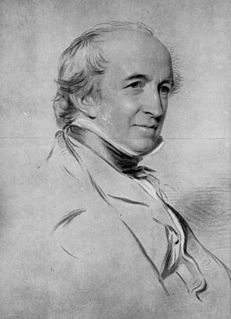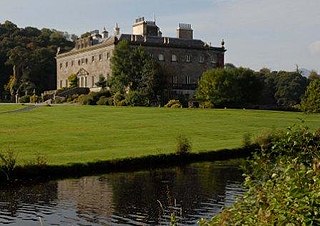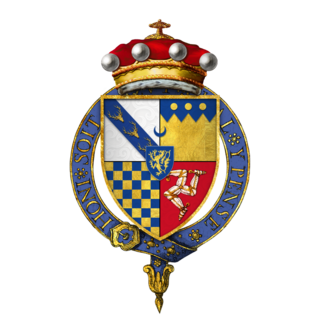Related Research Articles

Earl of Derby is a title in the Peerage of England. The title was first adopted by Robert de Ferrers, 1st Earl of Derby, under a creation of 1139. It continued with the Ferrers family until the 6th Earl forfeited his property toward the end of the reign of Henry III and died in 1279. Most of the Ferrers property and the Derby title were then held by the family of Henry III. The title merged in the Crown upon Henry IV's accession to the throne in 1399.
The Peerage of Ireland consists of those titles of nobility created by the English monarchs in their capacity as Lord or King of Ireland, or later by monarchs of the United Kingdom of Great Britain and Ireland. It is one of the five divisions of Peerages in the United Kingdom. The creation of such titles came to an end in the 19th century. The ranks of the Irish peerage are duke, marquess, earl, viscount and baron. As of 2016, there were 135 titles in the Peerage of Ireland extant: two dukedoms, ten marquessates, 43 earldoms, 28 viscountcies, and 52 baronies. The Crown of the United Kingdom of Great Britain and Northern Ireland continues to exercise jurisdiction over the Peerage of Ireland, including those peers whose titles derive from places located in what is now the Republic of Ireland. Article 40.2 of the Constitution of Ireland forbids the state conferring titles of nobility and an Irish citizen may not accept titles of nobility or honour except with the prior approval of the Irish government. This issue has not arisen in respect of the Peerage of Ireland because no creation of titles in it has been made since the constitution came into force.

Thomas Spring Rice, 1st Baron Monteagle of Brandon, was a British Whig politician, who served as Chancellor of the Exchequer from 1835 to 1839.
The Peerage of the United Kingdom is one of the five Peerages in the United Kingdom. It comprises most peerages created in the United Kingdom of Great Britain and Ireland after the Acts of Union in 1801, when it replaced the Peerage of Great Britain. New peers continued to be created in the Peerage of Ireland until 1898.

Marquess of Sligo is a title in the Peerage of Ireland. It was created in 1800 for John Browne, 3rd Earl of Altamont. The Marquess holds the subsidiary titles of Baron Mount Eagle, of Westport in the County of Mayo, Viscount Westport, of Westport in the County of Mayo, Earl of Altamont, in the County of Mayo, Earl of Clanricarde and Baron Monteagle, of Westport in the County of Mayo. All these titles are in the Peerage of Ireland, except the Barony of Monteagle, which is in the Peerage of the United Kingdom. The latter peerage entitled the Marquesses to a seat in the House of Lords prior to the House of Lords Act 1999. The Earldom of Clanricarde was inherited by the sixth Marquess in 1916 according to a special remainder in the letters patent.

Baron Kilmaine is a title that has been created twice, both times in the Peerage of Ireland. The first creation came in 1722 in favour of the soldier the Hon. James O'Hara. Two years later he succeeded his father as Baron Tyrawley. However, both titles became extinct on the second Baron Tyrawley's death in 1773 without legitimate sons.

Earl of Clanricarde is a title that has been created twice in the Peerage of Ireland, first in 1543 and again in 1800. The former creation became extinct in 1916 while the 1800 creation is extant and held by the Marquess of Sligo since 1916.

Westport House in Westport, County Mayo, Ireland, is a country house, historically the family seat of the Marquess of Sligo and the Brownes and designed by notable eighteenth century architects Richard Cassels, Thomas Ivory and James Wyatt. The title and the house were separated in 2014, following the death of Jeremy Browne, 11th Marquess of Sligo, who left the estate to his five daughters. His titles passed to his first cousin, Sebastian Ulick Browne, a residential estate agent in Australia. The house was purchased by the Hughes Group in 2017.
This is a list of people who have served as Lord-Lieutenant of Mayo.
Monteagle may refer to :
Jeremy Ulick Browne, 11th Marquess of Sligo, styled Earl of Altamont until 1991, was an Irish hereditary peer and businessman. On the death of his father, he was entitled to sit in the House of Lords by virtue of the subsidiary title Baron Mounteagle, in the Peerage of the United Kingdom. However, he never took his seat and lost the right with the passage of the House of Lords Act 1999.
The Stanley family is an English family with many notable members, including the Earls of Derby and the Barons Audley who descended from the early holders of Audley and Stanley, Staffordshire. The two branches of the Audley family were made Barons Audley but both ended in the male line in the 14th century, after which their considerable estates were passed to a number of female heiresses, while the Stanleys would be elevated in the 15th century first to Barons Stanley and then Earls of Derby, a title they continue to hold.
John Thomas Browne, 4th Marquess of Sligo, styled Lord John Browne until 1868, was an Irish politician and naval commander.

Lady Mary Brandon was an English noblewoman, and the daughter of Charles Brandon, 1st Duke of Suffolk, by his second wife, Anne Browne. Mary was the wife of Thomas Stanley, 2nd Baron Monteagle, by whom she had six children.
Denis Browne was an Irish politician.

John Browne, 1st Earl of Altamont, known as The Lord Mount Eagle between 1760 and 1768 and as The Viscount Westport between 1768 and 1771, was an Irish peer and politician. He began the building of Westport House and the town of Westport.

Edward Stanley, 1st Baron MonteagleKG (1460?–1523) was an English soldier who became a peer and Knight of the Garter. He is known for his deeds at the Battle of Flodden.
William Stanley, 3rd Baron Monteagle, of Hornby Castle, Lancashire, was an English politician. He was the son of Thomas Stanley, 2nd Baron Monteagle and Lady Mary Brandon, the daughter of Charles Brandon, 1st Duke of Suffolk, by his second wife, Anne Browne.
The order of precedence in Ireland was fixed by Royal Warrant on 2 January 1897 during Ireland's ties to the United Kingdom of Great Britain and Ireland.
References
- Kidd, Charles, Williamson, David (editors). Debrett's Peerage and Baronetage (1990 edition). New York: St Martin's Press, 1990.
- Leigh Rayment's Peerage Pages [ self-published source ][ better source needed ]
- ↑ "Notes to the diary: 1560 Pages 378-383 The Diary of Henry Machyn, Citizen and Merchant-Taylor of London, 1550-1563". British History Online. Camden Society, 1848. Retrieved 23 November 2022.